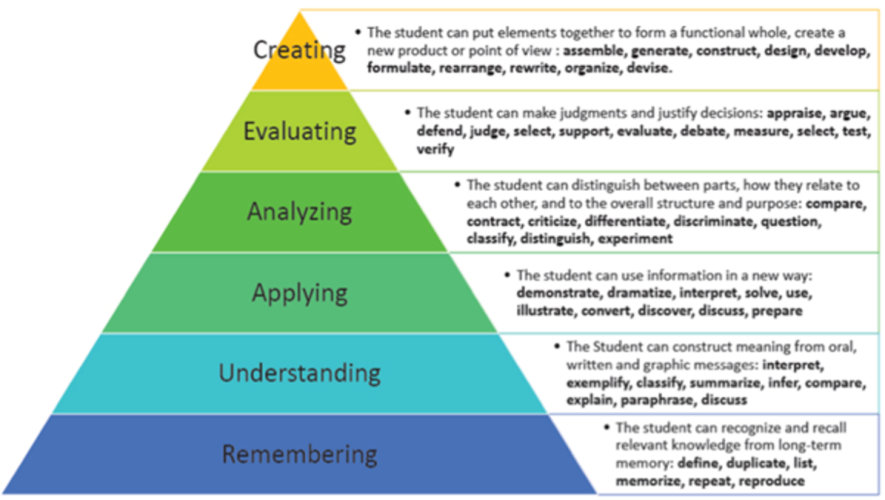Lorin Anderson, a former student of Bloom, and David Krathwohl (2001) updated and revised the Bloom’s taxonomy reflecting relevance to 21st century work for both students and teachers. The revisions they made in the Bloom’s taxonomy appear fairly minor; however, they do have significant impact on how people use the taxonomy. These changes can be divided into three broad categories;
- Terminology — Anderson modified the original terminology by changing Bloom’s taxonomy categories from nouns to verbs. Anderson renamed the knowledge category into remembering, comprehension into understanding and synthesis into creating categories.
- Structure — Anderson also changed the order of synthesis and placed it at the top of the triangle under the name of Creating.
- Emphasis — Anderson also considered two dimensions in the revised Bloom’s taxonomy which they represented as ‘Knowledge’ and ‘Cognitive Processes’ in the knowledge matrix.
According to Anderson and Krathwohl (2001), The two dimensions are:
- Knowledge Dimension (or the kind of knowledge to be learned) and
- Cognitive Process Dimension (or the cognitive processes to be used in acquiring knowledge).
Based on Anderson’s perspective, the Knowledge Dimension on the left side of the grid is composed of four kinds: Factual, Conceptual, Procedural, and Meta-Cognitive knowledge. The Cognitive Process Dimension across the top of the grid consists of six levels: Remembering, Understanding, Applying, Analyzing, Evaluating, and Creating.
| Remembering | Understanding | Applying | Analyzing | Evaluating | Creating | |
|---|---|---|---|---|---|---|
| Factual Knowledge | List | Summarize | Classify | Order | Rank | Compile |
| Conceptual Knowledge | Describe | Interpret | Experiment | Explain | Assess | Plan |
| Procedural Knowledge | Tabulate | Predict | Calculate | Differentiate | Conclude | Compose |
| Meta-Cognitive Knowledge | Appropriate use | Execute | Construct | Achieve | Action | Actualize |
Levels of Knowledge Dimension
The first three of these levels were identified in the original work, but rarely discussed or introduced when initially discussing uses for the taxonomy. Metacognition was added in the revised version.
1. Factual Knowledge
Factual Knowledge is knowledge that is basic to specific disciplines. This dimension refers to essential facts, terminology, details or elements students must know or be familiar with in order to understand a discipline or solve a problem in it.
2.Conceptual Knowledge
Conceptual Knowledge is knowledge of classifications, principles, generalizations, theories, models, or structures pertinent to a particular disciplinary area. The interrelationships among the basic elements within a larger structure that enable them to function together.
3. Procedural Knowledge
Procedural Knowledge refers to information or knowledge that helps students to do something specific to a discipline, subject, or area of study. It also refers to methods of inquiry, very specific or finite skills, algorithms, techniques, and particular methodologies.
4. Metacognitive Knowledge
Metacognitive Knowledge is the awareness of one’s own cognition and particular cognitive processes. It is strategic or reflective knowledge about how to go about solving problems, cognitive tasks, to include contextual and conditional knowledge and knowledge of self. Knowledge of cognition in general, as well as awareness and knowledge of one’s own cognition.
Levels of Cognitive Process Dimension (Cognitive Domain)
The new terms which are defined in revised Bloom’s taxonomy and the related key words and examples are;
1. Remembering
Remembering involves recognizing or recalling knowledge from memory. Remembering is when memory is used to produce or retrieve definitions, facts, or lists, or to recite previously learned information.
Key Words (Verbs) — Defines, Describes, Identifies, Knows, Labels, Lists, Matches, Names, Outlines, Recalls, Recognizes, Reproduces, Selects, States.
Examples (Learning Objectives) — The student will be able to; Recite a policy. Quote prices from memory to a customer. Recite the safety rules.
2. Understanding
Understanding involves constructing meaning from different types of functions be they written or graphic messages, or activities like interpreting, exemplifying, classifying, summarizing, inferring, comparing, or explaining.
Key Words (Verbs) — Comprehends, Converts, Defends, Distinguishes, Estimates, Explains, Extends, Generalizes, Gives an example, Infers, Interprets, Paraphrases, Predicts, Rewrites, Summarizes, Translates.
Examples (Learning Objectives) — The student will be able to; Rewrite the principles of test writing. Explain in one’s own words the steps for performing a complex task. Translate an equation into a computer spreadsheet.
3. Applying
Applying involves carrying out or using a procedure through executing, or implementing. Applying relates to or refers to situations where learned material is used through products like models, presentations, interviews or simulations.
Key Words (Verbs) — Applies, Changes, Computes, Constructs, Demonstrates, Discovers, Manipulates, Modifies, Operates, Predicts, Prepares, Produces, Relates, Shows, Solves, Uses.
Examples (Learning Objectives) — The student will be able to; Use a manual to calculate an employee’s vacation time. Apply laws of statistics to evaluate the reliability of a written test.
4. Analyzing
Analyzing involves breaking materials or concepts into parts, determining how the parts relate to one another or how they interrelate, or how the parts relate to an overall structure or purpose. Mental actions included in this function are differentiating, organizing, and attributing, as well as being able to distinguish between the components or parts. When one is analyzing, he/she can illustrate this mental function by creating spreadsheets, surveys, charts, or diagrams, or graphic representations.
Key Words (Verbs) — Analyzes, Breaks down, Compares, Contrasts, Diagrams, Deconstructs, Differentiates, Discriminates, Distinguishes, Identifies, Illustrates, Infers, Outlines, Relates, Selects, Separates.
Examples (Learning Objectives) — The student will be able to; Troubleshoot a piece of equipment by using logical deduction. Recognize logical fallacies in reasoning. Gathers information from a department and selects the required tasks for training.
5. Evaluating
Evaluating involves making judgments based on criteria and standards through checking and critiquing. Critiques, recommendations, and reports are some of the products that can be created to demonstrate the processes of evaluation. In the newer taxonomy, evaluating comes before creating as it is often a necessary part of the precursory behavior before one creates something.
Key Words (Verbs) — Appraises, Compares, Concludes, Contrasts, Criticizes, Critiques, Defends, Describes, Discriminates, Evaluates, Explains, Interprets, Justifies, Relates, Summarizes, Supports.
Examples (Learning Objectives) — The student will be able to; Select the most effective solution. Hire the most qualified candidate. Explain and justify a new budget.
6. Creating
Creating involves putting elements together to form a coherent or functional whole; reorganizing elements into a new pattern or structure through generating, planning, or producing. Creating requires users to put parts together in a new way, or synthesize parts into something new and different thus creating a new form or product. This process is the most difficult mental function in the new taxonomy.
Key Words (Verbs) — Categorizes, Combines, Compiles, Composes, Creates, Devises, Designs, Explains, Generates, Modifies, Organizes, Plans, Rearranges, Reconstructs, Relates, Reorganizes, Revises, Rewrites, Summarizes, Tells, Writes.
Examples (Learning Objectives) — The student will be able to; Write a company operations or process manual. Design a machine to perform a specific task. Integrates training from several sources to solve a problem. Revises and process to improve the outcome.
References
Anderson, L. W. and Krathwohl, D. R., et al (Eds..) (2001) A Taxonomy for Learning, Teaching, and Assessing: A Revision of Bloom’s Taxonomy of Educational Objectives. Allyn & Bacon. Boston, MA (Pearson Education Group)
OTHER RELATED POSTS
Bloom’s Taxonomy of Educational Objectives
SOLO Taxonomy versus Bloom’s Taxonomy



